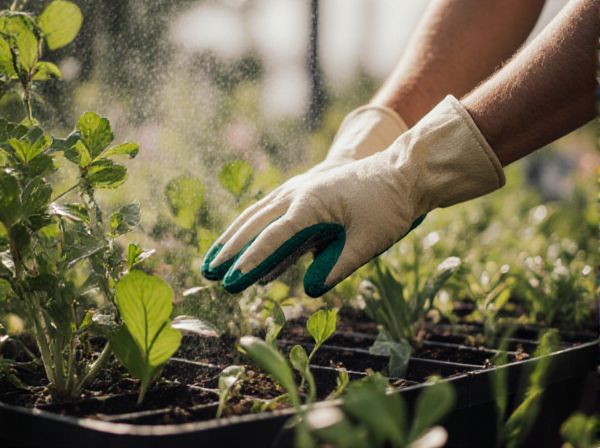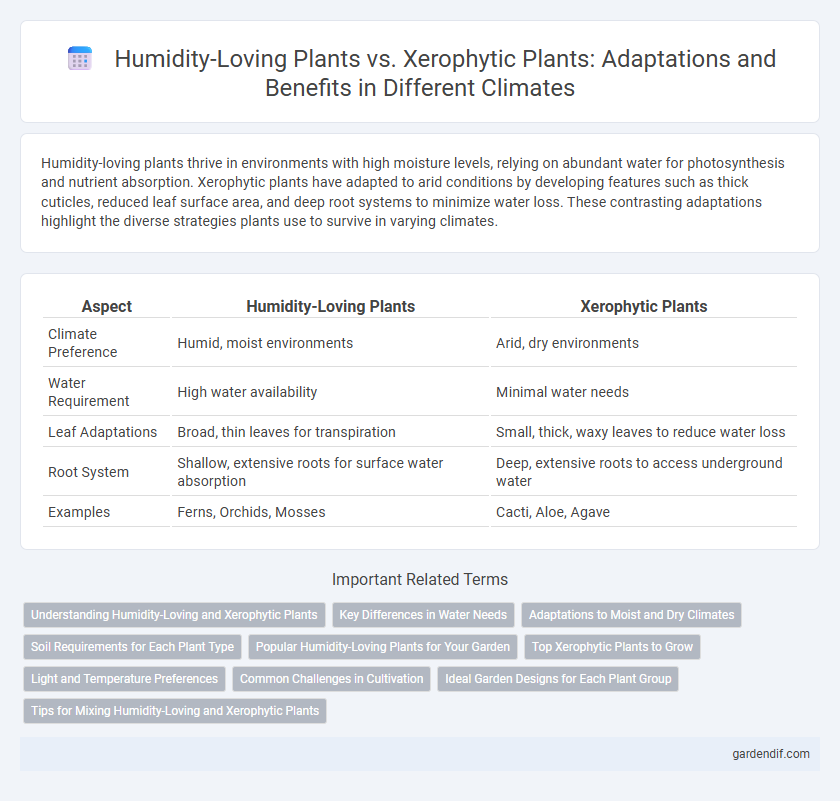
Humidity-loving plants vs Xerophytic plants Illustration
Humidity-loving plants thrive in environments with high moisture levels, relying on abundant water for photosynthesis and nutrient absorption. Xerophytic plants have adapted to arid conditions by developing features such as thick cuticles, reduced leaf surface area, and deep root systems to minimize water loss. These contrasting adaptations highlight the diverse strategies plants use to survive in varying climates.
Table of Comparison
| Aspect | Humidity-Loving Plants | Xerophytic Plants |
|---|---|---|
| Climate Preference | Humid, moist environments | Arid, dry environments |
| Water Requirement | High water availability | Minimal water needs |
| Leaf Adaptations | Broad, thin leaves for transpiration | Small, thick, waxy leaves to reduce water loss |
| Root System | Shallow, extensive roots for surface water absorption | Deep, extensive roots to access underground water |
| Examples | Ferns, Orchids, Mosses | Cacti, Aloe, Agave |
Understanding Humidity-Loving and Xerophytic Plants
Humidity-loving plants thrive in environments with high moisture levels, often exhibiting broad leaves and specialized structures to absorb and retain water efficiently. Xerophytic plants adapt to arid climates by developing thick cuticles, reduced leaf surface areas, and deep root systems to minimize water loss and maximize water uptake. Understanding these adaptations reveals the intricate ways plants optimize survival strategies based on moisture availability in their habitats.
Key Differences in Water Needs
Humidity-loving plants require consistently moist soil and thrive in environments with high atmospheric moisture, relying on frequent watering to maintain their hydration levels. Xerophytic plants have adapted to arid climates with minimal water availability by developing water storage tissues, reduced leaf surface area, and specialized root systems, allowing them to survive prolonged drought periods. The key difference lies in their water needs: humidity-loving plants demand abundant moisture, while xerophytes efficiently conserve water and tolerate dry conditions.
Adaptations to Moist and Dry Climates
Humidity-loving plants exhibit adaptations such as large, thin leaves with drip tips to efficiently shed excess water and prevent fungal growth, thriving in moist environments with high humidity and consistent rainfall. Xerophytic plants, adapted to arid and dry climates, possess thick, waxy cuticles, reduced leaf surface area, and deep root systems to minimize water loss and maximize water absorption. These specialized adaptations enable humidity-loving plants and xerophytes to survive and reproduce successfully in contrasting moisture conditions.
Soil Requirements for Each Plant Type
Humidity-loving plants thrive in soil with high organic matter content, excellent water retention, and consistent moisture levels to support their physiology. Xerophytic plants require well-drained, sandy or rocky soils with minimal water retention to prevent root rot, often enriched with minerals that enhance drought resistance. Understanding these soil preferences is crucial for optimizing growth conditions in humid versus arid climates.
Popular Humidity-Loving Plants for Your Garden
Popular humidity-loving plants for your garden include ferns, peace lilies, and calatheas, which thrive in moist, shaded environments with consistent humidity levels above 60%. These plants benefit from regular misting and well-draining soil that retains moisture without becoming waterlogged. In contrast to xerophytic plants adapted to dry, arid conditions, humidity-loving species require a stable microclimate to maintain vibrant foliage and prevent dehydration stress.
Top Xerophytic Plants to Grow
Top xerophytic plants to grow include cacti, agave, aloe vera, and yucca, all adapted to thrive in arid environments with minimal water. These species exhibit specialized traits such as thick, fleshy leaves, waxy surfaces, and deep root systems that reduce water loss and maximize moisture absorption. Choosing xerophytic plants not only conserves water but also enhances garden resilience in drought-prone climates.
Light and Temperature Preferences
Humidity-loving plants thrive in low light and moderate temperatures, often found in shaded, moist environments with temperatures ranging from 18degC to 25degC. Xerophytic plants favor high light exposure and can tolerate extreme temperatures, from 30degC up to 45degC, due to their adaptations for water conservation. These contrasting preferences highlight the specialized adaptations of plants to their respective humid or arid climates.
Common Challenges in Cultivation
Humidity-loving plants often struggle with fungal diseases and root rot due to excess moisture, requiring well-drained soil and adequate airflow for healthy growth. Xerophytic plants face challenges like water stress and nutrient scarcity, needing specialized adaptations such as thick cuticles and deep root systems to conserve moisture. Both plant types demand careful environmental control to balance moisture levels and prevent physiological stress while optimizing growth conditions.
Ideal Garden Designs for Each Plant Group
Humidity-loving plants thrive in garden designs featuring shaded areas with consistently moist, rich soil and high humidity levels, such as tropical or rainforest-themed gardens. Xerophytic plants require garden layouts emphasizing excellent drainage, sandy or rocky soils, and minimal watering, commonly found in desert or xeriscape gardens. Incorporating appropriate microclimates and soil conditions ensures optimal growth and sustainability for both plant groups in their respective garden environments.
Tips for Mixing Humidity-Loving and Xerophytic Plants
When mixing humidity-loving and xerophytic plants, place humidity-tolerant species like ferns and peace lilies in areas with consistent moisture and indirect light, while situating xerophytic plants such as succulents and cacti in well-draining soil with plenty of sunlight. Use separate pots or designated zones to prevent overwatering xerophytes, and monitor humidity levels to ensure optimal conditions for both plant types. Incorporating mulch and humidity trays near tropical plants can boost moisture without affecting drought-resistant neighbors.
Humidity-loving plants vs Xerophytic plants Infographic

 gardendif.com
gardendif.com